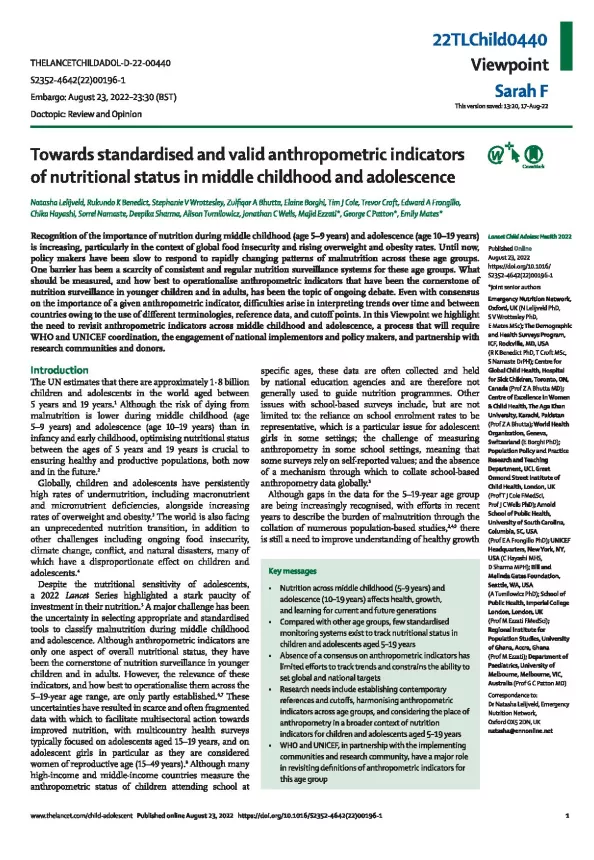Towards standardised and valid anthropometric indicators of nutritional status in middle childhood and adolescence
Publication details
Summary
Recognition of the importance of nutrition during middle childhood (age 5-9 years) and adolescence (age 10-19 years) is increasing, particularly in the context of global food insecurity and rising overweight and obesity rates. Until now, policy makers have been slow to respond to rapidly changing patterns of malnutrition across these age groups. One barrier has been a scarcity of consistent and regular nutrition surveillance systems for these age groups. What should be measured, and how best to operationalise anthropometric indicators that have been the cornerstone of nutrition surveillance in younger children and in adults, has been the topic of ongoing debate. Even with consensus on the importance of a given anthropometric indicator, difficulties arise in interpreting trends over time and between countries owing to the use of different terminologies, reference data, and cut-off points. In this Viewpoint we highlight the need to revisit anthropometric indicators across middle childhood and adolescence, a process that will require WHO and UNICEF coordination, the engagement of national implementers and policy makers, and partnership with research communities and donors.
Key messages
- Nutrition across middle childhood (5-9 years) and adolescence (10-19 years) affects health, growth, and learning for current and future generations.
- Compared with other age groups, few standardised monitoring systems exist to track nutritional status in children and adolescents aged 5-19 years.
- Absence of a consensus on anthropometric indicators has limited efforts to track trends and constrains the ability to set global and national targets.
- Research needs include establishing contemporary references and cutoffs, harmonising anthropometric indicators across age groups, and considering the place of anthropometry in a broader context of nutrition indicators for children and adolescents aged 5-19 years.
- WHO and UNICEF, in partnership with the implementing communities and research community, have a major role in revisiting definitions of anthropometric indicators for this age group.

Cite this publication
Reference this page
Natasha Lelijveld, Rukundo K Benedict, Stephanie V Wrottesley, Zulfiqar A Bhutta, Elaine Borghi, Tim J Cole, Trevor Croft, Edward A Frongillo, Chika Hayashi, Sorrel Namaste, Deepika Sharma, Alison Tumilowicz, Jonathan C Wells, Majid Ezzati, George C Patton, Emily Mates, Towards standardised and valid anthropometric indicators of nutritional status in middle childhood and adolescence, The Lancet Child & Adolescent Health, Volume 6, Issue 10, 2022, Pages 738-746, ISSN 2352-4642, https://doi.org/10.1016/S2352-4642(22)00196-1.